December 2023 | 19 photos | 5-minute read
In 1947, Maurice Wilks, the engineering director of the Rover company, sketched out the shape of a multipurpose vehicle in the sand on a beach in Wales, UK. A vehicle that could be ‘driven into the unknown’ — the Land Rover.
Created as a car that would double as a light tractor and off-roader, the Land Rover has since gone on to become synonymous with adventure, exploration, and reliability. Tough and intrepid, it has been a friend to farmers and explorers, fought wars, and been a saviour in natural disasters. The original Land Rover established its off-roading prowess from the very first series, mastering all manner of terrain and forces of nature.
1950s-1970s
Launched at the 1948 Amsterdam Motor Show, the car was an overnight success. A year after its launch, explorer Colonel LeBlanc drove his Land Rover from England to Ethiopia, establishing the car’s unique connection with overland expeditions. In 1951, a British automobile magazine dispatched a Land Rover from Kolkata, India, to Calais, France, on a 10,000km road trip. The only mechanical issue the team faced? A single tyre puncture.
The car was truly put to test in the mid-1950s with the Oxford and Cambridge University expeditions. The first one started as a bet between British university students at a bar in Hong Kong and turned into an epic overseas adventure — the Oxford and Cambridge Trans-Africa Expedition.
Two teams of undergraduates raced over 40,000km, crossing Africa from north to south, and back again. The expedition was a huge success, inspiring the famed 1955 Oxford and Cambridge Far Eastern Expedition. Two teams drove from London to Singapore and back to London, a distance of about 50,000km. It was a trip that many thought was impossible — across wastelands, an unmarked desert, virgin jungles and rivers. But the car proved itself more than capable with its intuitive dual range four-wheel drive system, four-speed gearbox, sturdy steel box-section chassis, aluminum body, and waterproof wiring.
The Oxford and Cambridge University expeditions culminated with teams driving through arduous landscapes across South America in 1957, having introduced the original Land Rover to far-flung corners of the world.
1980s-1990s
The 1970s closed on a high note with the Range Rover winning the inaugural Paris-Dakar Rally, one of the toughest sporting events in the world and the ultimate all-terrain endurance test. The next decade saw the start of a 17-year long association (from 1981 to 1998) with the Camel Trophy, also known as the Olympics of 4x4. This annual event helped Land Rover break new ground, both in terms of modifications to the cars — addition of winches, safety devices and other expedition, navigation and communication equipment — and in the locations it covered, ranging from the Amazon to Australasia and Siberia. Traversing treacherous routes through jungles and floating cars down rivers on rafts, this was not a driving challenge — the Camel Trophy expeditions pitted man and technology against the wilderness, in a crusade of sorts, where skills in kayaking, mountain biking and water sports became prerequisites to victory.
By the mid-1980s the Range Rover was exported to almost all parts of the world, except North America. This changed in 1987 when the first enhanced models made their way to the continent. Trying to come up with an impressive way to launch the 1990 Range Rover, the company put together the first Great Divide Expedition. Over 12 days in 1989, seven Range Rovers went on a 1,816km road trip along the Continental Divide in North America. The caravan travelled over some of the most daunting, unpaved roads and 4x4 trails in the continent, cruising through the high peaks of the Rocky Mountains.
2000s
The beginning of the new millennium saw a successor to the Camel Trophy — the Land Rover G4 Challenge. Launched in 2003, the month-long competition took after its predecessor in its extreme adventure sports nature, combining demanding 4x4 driving with clever strategy. Cutting through the rugged American east coast into South Africa and then uncharted Pilbara in Western Australia, its finale was on the arid sands of the Moab desert in Utah, US. The second challenge, in 2006, comprised a wider sweep — setting off in Thailand, driving through the jungles of Laos before heading towards Brazil and then through the vast salt plains of Salar de Uyuni in Bolivia, closing at an altitude of over 4,000m in the Andes Mountains.
In 2008, it was time for an adventure in the picturesque sand dunes neighbouring the Persian Gulf as part of the Oman Adventure. Steep and slippery all at the same time, the tricky desert topography pushed the Range Rover to prove its off-road prowess in the deepest part of the country.
2010s
The millionth Land Rover Discovery rolled out of the production line in 2012 and embarked on a fundraising expedition from Birmingham, UK, to Beijing, China, called the Journey of Discovery. Covering an expanse of 13,000km across 13 countries over 50 days, the expedition involved driving through challenging terrain, ranging from ice driving in Austria to sand crawling on Taklimakan Desert’s sun-baked sand dunes. Highlights included a stirring trip to Chernobyl (the first private vehicle trip allowed into the 30km exclusion zone), a visit to a former secret submarine shelter carved deep into the mountainside by the Black Sea in Balaklava and driving past rusting boats on the gargantuan desiccated Aral seabed.
In 2013, as Land Rover celebrated its 65th anniversary with the LXV Special Edition, two expeditions were set in motion. One completed the fastest recorded crossing of the Empty Quarter desert against scorching temperatures of 50°C in an 849km journey from Saudi Arabia to the United Arab Emirates border in just 10 hours 22 minutes. This was in large parts thanks to Land Rover’s breakthrough lightweight suspension design and innovative dynamic chassis technologies with the all-aluminium architecture that takes the weight-saving to more than 420kg.
The second was the Silk Trail, a first-of-its-kind expedition that showcased the capability of three Range Rover diesel hybrid prototypes. The 17,000km journey started from Solihull, UK, and ended in Mumbai, India, traversing 13 countries over 53 days. The route included part of the ancient 6,500km trade route that connected Asia with the Mediterranean. The route tested man and machine, with desert trails in 43°C heat, pothole-riddled roads, vast distances of mud and gravel tracks, chaotic city streets, passes clinging to the edges of mountains and high-altitude drives (with oxygen content in the air reduced to 10%). Crossing China’s Xinjiang-Tibet highway (over 5,300m above sea level) the hybrids made history as the first foreign-registered cars to drive there
In 2019, the Land Rover Defender made a dazzling comeback in a new and advanced avatar at its world premiere at the 2019 Frankfurt Motor Show — the last stop of the Expedition 001. The journey commenced amidst the towering 300m canyons of the Valley of the Castles in the remote Charyn Canyon, on the Kazakhstan-China border. Known as one of the most land-locked places on the planet, the undulating landscape was an apt setting for the New Land Rover Defender to display its highly capable and versatile all-terrain capabilities and prove itself a worthy successor.
Since its launch 75 years ago, the Land Rover has seen many iterations while retaining its simplicity and charm. A rugged workhorse, it has ferried royalty, movie stars and explorers alike, always going the extra mile for those looking to drive into the unknown.
- Text by Tejal Pandey. Images and video courtesy Jaguar Land Rover.
































